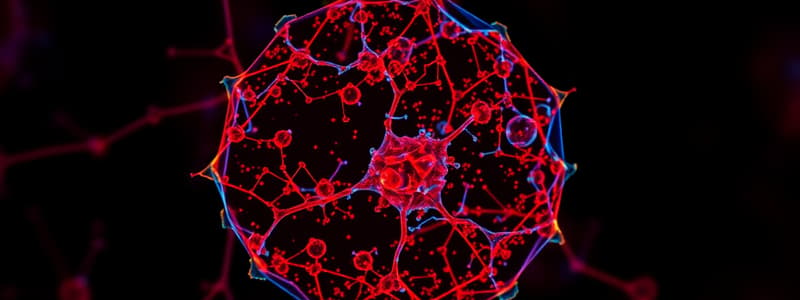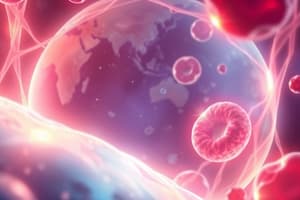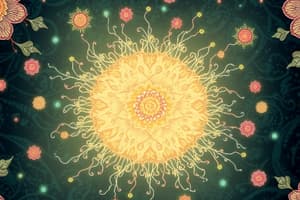Podcast
Questions and Answers
What specific area of research led to the discovery of stem cells by McCulloch and Till?
What specific area of research led to the discovery of stem cells by McCulloch and Till?
- Effects of chemotherapy on bone marrow
- Genetic mutations in blood cells
- The role of viruses in causing leukemia
- Impact of nuclear radiation on bone marrow cells (correct)
What surprising observation did McCulloch and Till make in the spleens of the mice?
What surprising observation did McCulloch and Till make in the spleens of the mice?
- Development of cancerous tumors in the spleen
- Presence of nodules correlated with surviving marrow cells (correct)
- Enlarged spleen size in all mice
- Uniform distribution of blood cells within the spleen
How did McCulloch and Till track the origins of cells within each nodule?
How did McCulloch and Till track the origins of cells within each nodule?
- By inducing genetic mutations in the donor cells
- By injecting a fluorescent dye into the donor cells
- Using radioactive isotopes to label the donor cells
- By creating markers on the chromosomes of donor cells through irradiation (correct)
What did the term "colony-forming units" specifically refer to?
What did the term "colony-forming units" specifically refer to?
In what year were the groundbreaking findings of McCulloch and Till's research published in Nature?
In what year were the groundbreaking findings of McCulloch and Till's research published in Nature?
What key characteristic defines stem cells, as revealed by the research?
What key characteristic defines stem cells, as revealed by the research?
Apart from bone marrow, where else can stem cells be found in adult organisms?
Apart from bone marrow, where else can stem cells be found in adult organisms?
What is the significance of Shinya Yamanaka's work in 2006?
What is the significance of Shinya Yamanaka's work in 2006?
What term describes the process of converting mature cells into stem cells?
What term describes the process of converting mature cells into stem cells?
Which scientist described their work as a case study in "the importance of serendipity in scientific research"?
Which scientist described their work as a case study in "the importance of serendipity in scientific research"?
Flashcards
McCulloch and Till
McCulloch and Till
Researchers who discovered stem cells in 1961.
Stem cells
Stem cells
Cells with the potential to become various specialized cell types and can self-renew.
Serendipity in science
Serendipity in science
Unexpected discoveries that lead to significant breakthroughs.
Colony-forming units (CFUs)
Colony-forming units (CFUs)
Signup and view all the flashcards
Irradiation experiment
Irradiation experiment
Signup and view all the flashcards
Nodules in spleens
Nodules in spleens
Signup and view all the flashcards
Induced pluripotent stem cells (iPS cells)
Induced pluripotent stem cells (iPS cells)
Signup and view all the flashcards
James Till's quote
James Till's quote
Signup and view all the flashcards
Bone marrow significance
Bone marrow significance
Signup and view all the flashcards
Nobel Prize in 2012
Nobel Prize in 2012
Signup and view all the flashcards
Study Notes
McCulloch and Till's Discovery
- McCulloch and Till's combined skills in cellular biology and biophysics led to a groundbreaking discovery about bone marrow cells.
- Their serendipitous finding involved unexpectedly discovering a special type of cell—a stem cell—capable of differentiating into various specialized cells.
- These stem cells possess unique self-renewal and multiplication abilities.
Unexpected Development and Stem Cell Discovery
- McCulloch's curiosity about radiation effects on cancer cells and Till's expertise in radiation sensitivity led to experiments exposing mice to radiation and transplanting new bone marrow to the irradiated mice.
- Observing the resulting bumps, or nodules, in the mice spleens led to the finding that the number of bumps corresponded directly to the number of live bone marrow cells.
Colonies of Clones
- Further experiments sought to determine if the nodules emerged from a single cell or multiple cells.
- Utilizing radiation to the donor cells created a marker visible in the altered chromosomes of new cells, demonstrating that each nodule stemmed from a single progenitor cell.
- These cells were called "colony-forming units" and were a crucial discovery.
Marrow Cell Composition
- Remarkably, the colonies in each nodule comprised cells that developed into the different blood cell types (red blood cells, white blood cells, and platelets).
Publication and Significance
- The research findings were published in 1961 in a straightforward title, initiating further investigation into bone marrow.
- Subsequent publications in Nature emphasized that bone marrow contains specialized cells that can self-replicate and differentiate into diverse cell types.
- Stem cells are prominent components in tissue regeneration, particularly in damaged tissues.
Yamanaka's Work in Reprogramming Cells
- Stem cells exist in all developmental life stages, enabling cells to regenerate and repair damaged tissues.
- Yamanaka successfully reprogrammed adult skin cells (2006) into pluripotent stem cells in mice, a groundbreaking feat demonstrating the ability of induced pluripotent stem cells (iPS) to produce any type of body cell.
- His work and contributions to induced pluripotent stem cells (iPS) were highly regarded leading to a shared Nobel Prize.
Studying That Suits You
Use AI to generate personalized quizzes and flashcards to suit your learning preferences.





